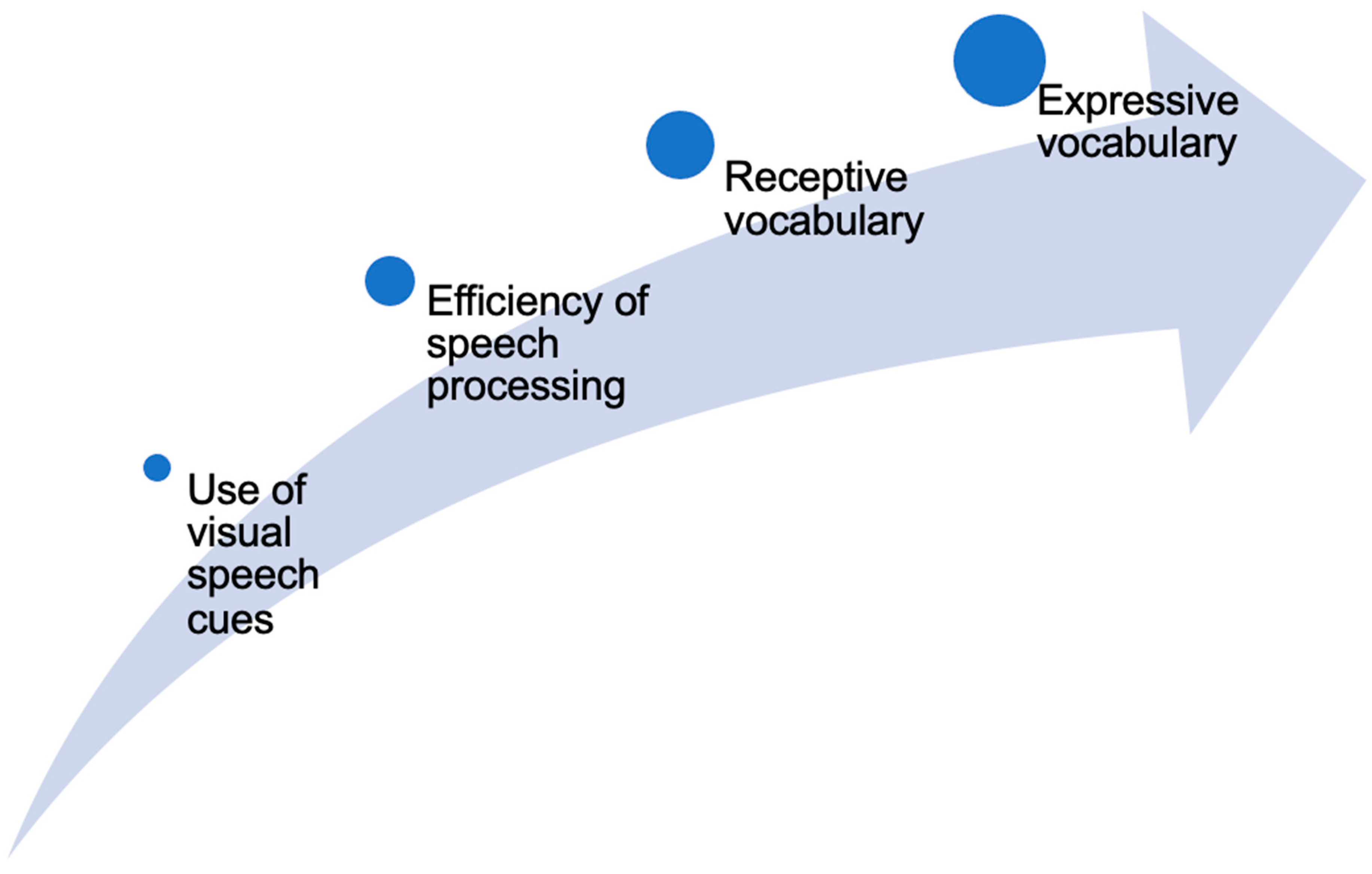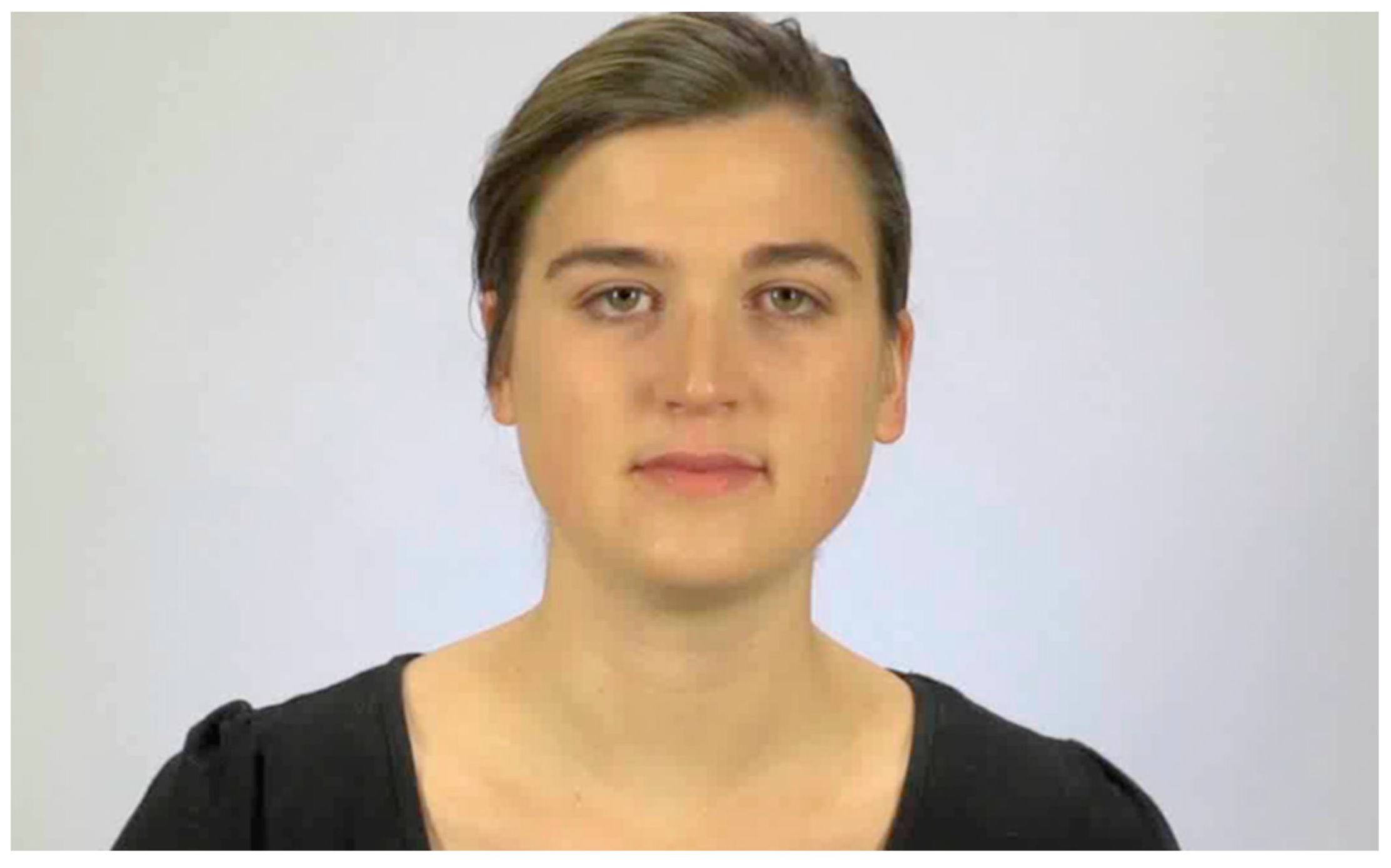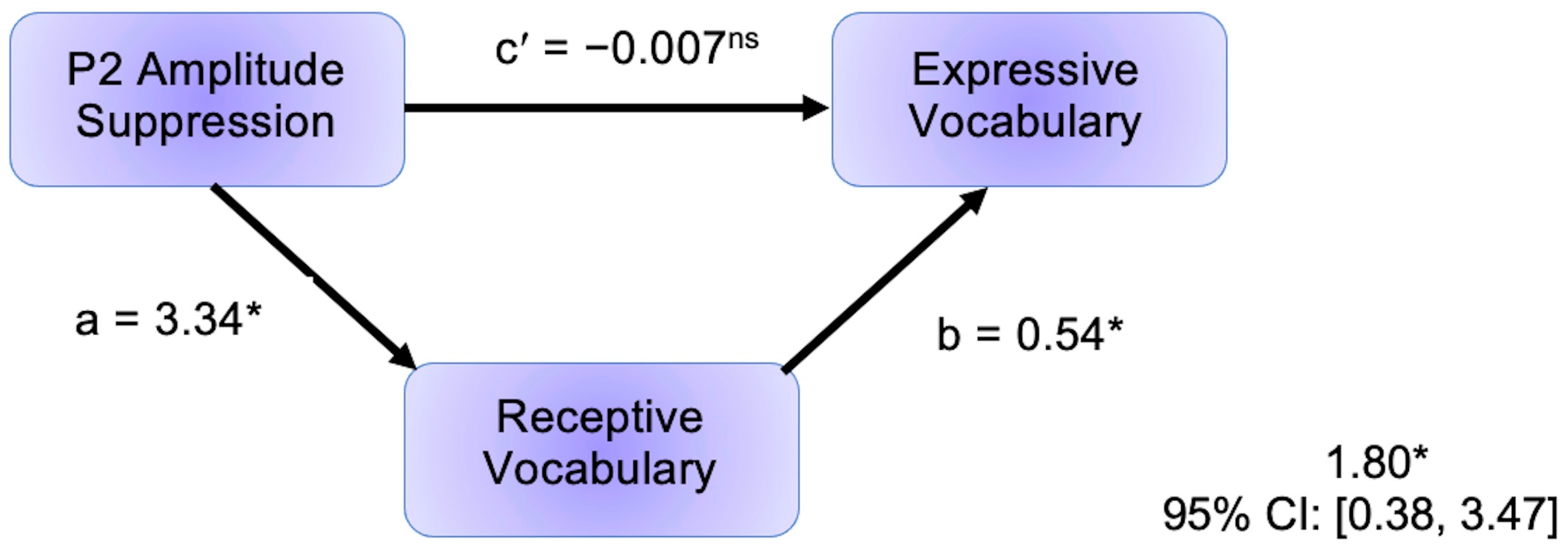The Processing of Audiovisual Speech Is Linked with Vocabulary in Autistic and Nonautistic Children: An ERP Study
Abstract
:1. Introduction
1.1. Research Background
1.2. Research Questions and Hypotheses
- Is the efficiency of audiovisual speech processing—as approximated by P2 amplitude suppression—reduced, on average, in autistic children compared to their nonautistic peers?
- Is the efficiency of audiovisual speech processing, as indexed by the degree of amplitude suppression displayed, positively associated with vocabulary in autistic and nonautistic children? Specifically, does the degree of amplitude suppression displayed indirectly influence expressive vocabulary through its relation with receptive vocabulary?
2. Materials and Methods
2.1. Design Overview
2.2. Participants
2.3. Stimuli
2.4. Measurement of Efficiency of Audiovisual Speech Processing
2.5. Measurement of Receptive and Expressive Vocabulary
2.6. Data Processing and Analytic Plan
3. Results
3.1. Results Relevant to Research Question 1: Processing of Audiovisual and Auditory-Only Speech According to Group
3.2. Results Relevant to Research Question 2: Indirect Effect of P2 Amplitude Suppression on Vocabulary
3.3. Post Hoc Analyses
4. Discussion
Limitations and Future Directions
5. Conclusions
Author Contributions
Funding
Institutional Review Board Statement
Informed Consent Statement
Data Availability Statement
Conflicts of Interest
References
- American Psychiatric Association. Diagnostic and Statistical Manual of Mental Disorders, 5th ed.; American Psychiatric Publishing: Arlington, VA, USA, 2013. [Google Scholar] [CrossRef]
- Billstedt, E.; Gillberg, I.C.; Gillberg, C. Autism in adults: Symptom patterns and early childhood predictors. Use of the DISCO in a community sample followed from childhood. J. Child Psychol. Psychiatry 2007, 48, 1102–1110. [Google Scholar] [CrossRef]
- Amendah, D.; Grosse, S.D.; Peacock, G.; Mandell, D.S. The economic costs of autism: A review. In Autism Spectrum Disorders; Amaral, D., Geschwind, D., Dawson, G., Eds.; Oxford University Press: Oxford, UK, 2011; pp. 1347–1360. [Google Scholar]
- Eisenberg, L. The autistic child in adolescence. Am. J. Psychiatry 1956, 112, 607–612. [Google Scholar] [CrossRef] [PubMed]
- Kobayashi, R.; Murata, T.; Yoshinaga, K. A follow-up study of 201 children with autism in Kyushu and Yamaguchi areas, Japan. J. Autism Dev. Disord. 1992, 22, 395–411. [Google Scholar] [CrossRef] [PubMed]
- Gillberg, C.; Steffenburg, S. Outcome and prognostic factors in infantile autism and similar conditions: A population-based study of 46 cases followed through puberty. J. Autism Dev. Disord. 1987, 17, 273–287. [Google Scholar] [CrossRef] [PubMed]
- Friedman, L.; Sterling, A.; DaWalt, L.S.; Mailick, M.R. Conversational language is a predictor of vocational independence and friendships in adults with ASD. J. Autism Dev. Disord. 2019, 49, 4294–4305. [Google Scholar] [CrossRef]
- Yoder, P.; Watson, L.R.; Lambert, W. Value-added predictors of expressive and receptive language growth in initially nonverbal preschoolers with autism spectrum disorders. J. Autism Dev. Disord. 2015, 45, 1254–1270. [Google Scholar] [CrossRef]
- Tager-Flusberg, H.; Paul, R.; Lord, C. Language and Communication in Autism. In Handbook of Autism and Pervasive Developmental Disorders, Vol. 1: Diagnosis, Development, Neurobiology, and Behavior, 3rd ed.; Volkmar, F.R., Paul, R., Klin, A., Cohen, D., Eds.; John Wiley & Sons Inc: Hoboken, NJ, USA, 2005; pp. 335–364. [Google Scholar]
- Tager-Flusberg, H. Risk factors associated with language in autism spectrum disorder: Clues to underlying mechanisms. J. Speech Lang. Hear. Res. 2016, 59, 143–154. [Google Scholar] [CrossRef] [Green Version]
- Irwin, J.; DiBlasi, L. Audiovisual speech perception: A new approach and implications for clinical populations. Lang. Linguist. Compass 2017, 11, 77–91. [Google Scholar] [CrossRef] [Green Version]
- Smith, E.; Zhang, S.; Bennetto, L. Temporal synchrony and audiovisual integration of speech and object stimuli in autism. Res. Autism Spectr. Disord. 2017, 39, 11–19. [Google Scholar] [CrossRef]
- Stevenson, R.; Siemann, J.K.; Schneider, B.C.; Eberly, H.E.; Woynaroski, T.G.; Camarata, S.M.; Wallace, M.T. Multisensory temporal integration in autism spectrum disorders. J. Neurosci. 2014, 34, 691–697. [Google Scholar] [CrossRef] [Green Version]
- Woynaroski, T.G.; Kwakye, L.D.; Foss-Feig, J.H.; Stevenson, R.A.; Stone, W.L.; Wallace, M.T. Multisensory speech perception in children with autism spectrum disorders. J. Autism Dev. Disord. 2013, 43, 2891–2902. [Google Scholar] [CrossRef] [PubMed] [Green Version]
- Feldman, J.I.; Dunham, K.; Cassidy, M.; Wallace, M.T.; Liu, Y.; Woynaroski, T.G. Audiovisual multisensory integration in individuals with autism spectrum disorder: A systematic review and meta-analysis. Neurosci. Biobehav. Rev. 2018, 95, 220–234. [Google Scholar] [CrossRef]
- Chandrasekaran, C.; Trubanova, A.; Stillittano, S.; Caplier, A.; Ghazanfar, A. The Natural Statistics of Audiovisual Speech. PLoS Comput. Biol. 2009, 5, e1000436. [Google Scholar] [CrossRef] [Green Version]
- Calvert, G.A.; Brammer, M.J.; Iversen, S.D. Crossmodal identification. Trends Cogn. Sci. 1998, 2, 247–253. [Google Scholar] [CrossRef]
- Massaro, D. Perceiving Talking Faces: From Speech Perception to a Behavioral Principle; MIT Press: Cambridge, MA, USA, 1998. [Google Scholar]
- Cascio, C.J.; Woynaroski, T.; Baranek, G.T.; Wallace, M.T. Toward an interdisciplinary approach to understanding sensory function in autism spectrum disorder. Autism Res. 2016, 9, 920–925. [Google Scholar] [CrossRef] [Green Version]
- Wallace, M.T.; Woynaroski, T.G.; Stevenson, R.A. Multisensory integration as a window into orderly and disrupted cognition and communication. Annu. Rev. Psychol. 2020, 71, 193–219. [Google Scholar] [CrossRef] [Green Version]
- Patten, E.; Watson, L.R.; Baranek, G.T. Temporal synchrony detection and associations with language in young children with ASD. Autism Res. Treat. 2014, 2014, 786346. [Google Scholar] [CrossRef] [PubMed]
- Righi, G.; Tenenbaum, E.J.; McCormick, C.; Blossom, M.; Amso, D.; Sheinkopf, S.J. Sensitivity to audio-visual synchrony and its relation to language abilties in children with and without ASD. Autism Res. 2018, 11, 645–653. [Google Scholar] [CrossRef]
- Santapuram, P.; Feldman, J.I.; Bowman, S.M.; Raj, S.; Suzman, E.; Crowley, S.; Kim, S.Y.; Keceli-Kaysili, B.; Bottema-Beutel, K.; Lewkowicz, D.J. Mechanisms by which early eye gaze to the mouth during multisensory speech influences expressive communication development in infant siblings of children with and without autism. Mind Brain Educ. 2022, 16, 62–74. [Google Scholar] [CrossRef]
- Heikkilä, J.; Lonka, E.; Meronen, A.; Tuovinen, S.; Eronen, R.; Leppänen, P.H.; Richardson, U.; Ahonen, T.; Tiippana, K. The effect of audiovisual speech training on the phonological skills of children with specific language impairment (SLI). Child Lang. Teach. Ther. 2018, 34, 269–287. [Google Scholar] [CrossRef] [Green Version]
- Feldman, J.I.; Conrad, J.G.; Kuang, W.; Tu, A.; Liu, Y.; Simon, D.M.; Wallace, M.T.; Woynaroski, T.G. Relations between the McGurk effect, social and communication skill, and autistic features in children with and without autism. J. Autism Dev. Disord. 2022, 52, 1920–1928. [Google Scholar] [CrossRef] [PubMed]
- Lewkowicz, D.J.; Hansen-Tift, A.M. Infants deploy selective attention to the mouth of a talking face when learning speech. Proc. Natl. Acad. Sci. USA 2012, 109, 1431–1436. [Google Scholar] [CrossRef]
- Soto-Faraco, S.; Calabresi, M.; Navarra, J.; Werker, J.F.; Lewkowicz, D.J. The development of audiovisual speech perception. In Multisensory Development; Bremner, A.J., Lewkowicz, D.J., Spence, C., Eds.; Oxford University Press: Oxford, UK, 2012; pp. 207–228. [Google Scholar] [CrossRef]
- Pons, F.; Bosch, L.; Lewkowicz, D.J. Twelve-month-old infants’ attention to the eyes of a talking face is associated with communication and social skills. Infant Behav. Dev. 2019, 54, 80–84. [Google Scholar] [CrossRef] [PubMed]
- Barenholtz, E.; Mavica, L.; Lewkowicz, D.J. Language familiarity modulates relative attention to the eyes and mouth of a talker. Cognition 2016, 147, 100–105. [Google Scholar] [CrossRef] [PubMed] [Green Version]
- Buchan, J.N.; Paré, M.; Munhall, K.G. The effect of varying talker identity and listening conditions on gaze behavior during audiovisual speech perception. Brain Res. 2008, 1242, 162–171. [Google Scholar] [CrossRef] [Green Version]
- Schwartz, J.-L.; Berthommier, F.; Savariaux, C. Seeing to hear better: Evidence for early audio-visual interactions in speech identification. Cognition 2004, 93, B69–B78. [Google Scholar] [CrossRef]
- Sumby, W.H.; Pollack, I. Visual contribution to speech intelligibility in noise. J. Acoust. Soc. Am. 1954, 26, 212–215. [Google Scholar] [CrossRef] [Green Version]
- Fraser, S.; Gagné, J.-P.; Alepins, M.; Dubois, P. Evaluating the effort expended to understand speech in noise using a dual-task paradigm: The effects of providing visual speech cues. J. Speech Lang. Hear. Res. 2010, 53, 18–33. [Google Scholar] [CrossRef]
- Drijvers, L.; Holler, J. The multimodal facilitation effect in human communication. Psychon. Bull. Rev. 2023, 30, 792–801. [Google Scholar] [CrossRef]
- De Gelder, B.; Vroomen, J.; Van der Heide, L. Face recognition and lip-reading in autism. Eur. J. Cogn. Psychol. 1991, 3, 69–86. [Google Scholar] [CrossRef]
- Irwin, J.R.; Tornatore, L.A.; Brancazio, L.; Whalen, D.H. Can children with autism spectrum disorders “hear” a speaking face? Child Dev. 2011, 82, 1397–1403. [Google Scholar] [CrossRef] [PubMed] [Green Version]
- Mongillo, E.A.; Irwin, J.R.; Whalen, D.; Klaiman, C.; Carter, A.S.; Schultz, R.T. Audiovisual processing in children with and without autism spectrum disorders. J. Autism Dev. Disord. 2008, 38, 1349–1358. [Google Scholar] [CrossRef]
- Smith, E.G.; Bennetto, L. Audiovisual speech integration and lipreading in autism. J. Child Psychol. Psychiatry 2007, 48, 813–821. [Google Scholar] [CrossRef]
- Williams, J.H.G.; Massaro, D.W.; Peel, N.J.; Bosseler, A.; Suddendorf, T. Visual–auditory integration during speech imitation in autism. Res. Dev. Disabil. 2004, 25, 559–575. [Google Scholar] [CrossRef]
- Iarocci, G.; Rombough, A.; Yager, J.; Weeks, D.J.; Chua, R. Visual influences on speech perception in children with autism. Autism 2010, 14, 305–320. [Google Scholar] [CrossRef] [Green Version]
- Van Wassenhove, V.; Grant, K.W.; Poeppel, D. Visual speech speeds up the neural processing of auditory speech. Proc. Natl. Acad. Sci. USA 2005, 102, 1181–1186. [Google Scholar] [CrossRef]
- Maeno, T.; Gjini, K.; Iramina, K.; Eto, F.; Ueno, S. Event-related potential P2 derived from visual attention to the hemi-space. Source localization with LORETA. Int. Congr. Ser. 2004, 1270, 262–265. [Google Scholar] [CrossRef]
- Shedden, J.M.; Nordgaard, C.L. ERP time course of perceptual and post-perceptual mechanisms of spatial selection. Cogn. Brain Res. 2001, 11, 59–75. [Google Scholar] [CrossRef] [PubMed]
- Kaganovich, N.; Schumaker, J. Audiovisual integration for speech during mid-childhood: Electrophysiological evidence. Brain Lang. 2014, 139, 36–48. [Google Scholar] [CrossRef] [Green Version]
- Baart, M.; Stekelenburg, J.J.; Vroomen, J. Electrophysiological evidence for speech-specific audiovisual integration. Neuropsychologia 2014, 53, 115–121. [Google Scholar] [CrossRef] [PubMed]
- Giard, M.-H.; Besle, J. Methodological considerations: Electrophysiology of multisensory interactions in humans. In Multisensory Object Perception in the Primate Brain; Springer: New York, NY, USA, 2010; pp. 55–70. [Google Scholar]
- Knowland, V.C.; Mercure, E.; Karmiloff-Smith, A.; Dick, F.; Thomas, M.S. Audio-visual speech perception: A developmental ERP investigation. Dev. Sci. 2014, 17, 110–124. [Google Scholar] [CrossRef] [Green Version]
- Treille, A.; Vilain, C.; Kandel, S.; Sato, M. Electrophysiological evidence for a self-processing advantage during audiovisual speech integration. Exp. Brain Res. 2017, 235, 2867–2876. [Google Scholar] [CrossRef] [PubMed] [Green Version]
- Basirat, A.; Brunellière, A.; Hartsuiker, R. The role of audiovisual speech in the early stages of lexical processing as revealed by the ERP word repetition effect. Lang. Learn. 2018, 68, 80–101. [Google Scholar] [CrossRef] [Green Version]
- Foxe, J.J.; Molholm, S.; Del Bene, V.A.; Frey, H.-P.; Russo, N.N.; Blanco, D.; Saint-Amour, D.; Ross, L.A. Severe multisensory speech integration deficits in high-functioning school-aged children with autism spectrum disorder (ASD) and their resolution during early adolescence. Cereb. Cortex 2015, 25, 298–312. [Google Scholar] [CrossRef] [PubMed] [Green Version]
- Stevenson, R.A.; Segers, M.; Ncube, B.L.; Black, K.R.; Bebko, J.M.; Ferber, S.; Barense, M.D. The cascading influence of multisensory processing on speech perception in autism. Autism 2018, 22, 609–624. [Google Scholar] [CrossRef] [Green Version]
- Hayes, A.F. Beyond Baron and Kenny: Statistical mediation analysis in the new millennium. Commun. Monogr. 2009, 76, 408–420. [Google Scholar] [CrossRef]
- Dunham, K.; Feldman, J.I.; Liu, Y.; Cassidy, M.; Conrad, J.G.; Santapuram, P.; Suzman, E.; Tu, A.; Butera, I.; Simon, D.M.; et al. Stability of variables derived from measures of multisensory function in children with autism spectrum disorder. Am. J. Intellect. Dev. Disabil. 2020, 125, 287–303. [Google Scholar] [CrossRef]
- Cassidy, S.; Robertson, I.H.; O’Connell, R.G. Retest reliability of event-related potentials: Evidence from a variety of paradigms. Psychophysiology 2012, 49, 659–664. [Google Scholar] [CrossRef]
- Huffmeijer, R.; Bakermans-Kranenburg, M.J.; Alink, L.R.; van IJzendoorn, M.H. Reliability of event-related potentials: The influence of number of trials and electrodes. Physiol. Behav. 2014, 130, 13–22. [Google Scholar] [CrossRef]
- DeVellis, R.F. Classical test theory. Med. Care 2006, 44, S50–S59. [Google Scholar] [CrossRef]
- Nunnally, J. Psychometric Theory, 2nd ed.; McGraw: New York, NY, USA, 1978. [Google Scholar]
- Feldman, J.I.; Cassidy, M.; Liu, Y.; Kirby, A.V.; Wallace, M.T.; Woynaroski, T.G. Relations between sensory responsiveness and features of autism in children. Brain Sci. 2020, 10, 775. [Google Scholar] [CrossRef] [PubMed]
- Feldman, J.I.; Dunham, K.; Conrad, J.G.; Simon, D.M.; Cassidy, M.; Liu, Y.; Tu, A.; Broderick, N.; Wallace, M.T.; Woynaroski, T.G. Plasticity of temporal binding in children with autism spectrum disorder: A single case experimental design perceptual training study. Res. Autism Spectr. Disord. 2020, 74, 101555. [Google Scholar] [CrossRef]
- Fritz, M.S.; MacKinnon, D.P. Required sample size to detect the mediated effect. Psychol. Sci. 2007, 18, 233–239. [Google Scholar] [CrossRef] [Green Version]
- Roid, G.H.; Miller, L.J.; Pomplun, M.; Koch, C. Leiter International Performance Scale, 3rd ed.; Western Psychological Services: Torrance, CA, USA, 2013. [Google Scholar]
- Martin, N.T.; Brownell, R. Receptive One-Word Picture Vocabulary Test, 4th ed.; Academic Therapy Publications: Novato, CA, USA, 2010. [Google Scholar]
- Brownell, R. Expressive One-Word Picture Vocabulary Test, 4th ed.; Academic Therapy Publications: Novato, CA, USA, 2010. [Google Scholar]
- Lord, C.; Rutter, M.; DiLavore, P.; Risi, S.; Gotham, K.; Bishop, S.L. Autism Diagnostic Observation Schedule, Second Edition (ADOS-2) Manual (Part I): Modules 1–4; Western Psychological Services: Los Angeles, CA, USA, 2012. [Google Scholar]
- Rutter, M.; Bailey, A.; Lord, C. Social Communication Questionnaire; Western Psychological Services: Los Angeles, CA, USA, 2003. [Google Scholar]
- Delorme, A.; Makeig, S. EEGLAB: An open source toolbox for analysis of single-trial EEG dynamics including independent component analysis. J. Neurosci. Methods 2004, 134, 9–21. [Google Scholar] [CrossRef] [Green Version]
- Simon, D.M.; Wallace, M.T. Integration and temporal processing of asynchronous audiovisual speech. J. Cogn. Neurosci. 2018, 30, 319–337. [Google Scholar] [CrossRef]
- R Core Team. R: A Langauge and Environment for Statistical Computing 4.0.2; R Core Team: Vienna, Austria, 2020. [Google Scholar]
- Hayes, A.F. Introduction to Mediation, Moderation, and Conditional Process Analysis: A Regression-Based Approach; Guilford Publications: New York, NY, USA, 2017. [Google Scholar]
- Hudry, K.; Leadbitter, K.; Temple, K.; Slonims, V.; McConachie, H.; Aldred, C.; Howlin, P.; Charman, T. Preschoolers with autism show greater impairment in receptive compared with expressive language abilities. Int. J. Lang. Commun. Disord. 2010, 45, 681–690. [Google Scholar] [CrossRef] [PubMed]
- Kjelgaard, M.M.; Tager-Flusberg, H. An Investigation of Language Impairment in Autism: Implications for Genetic Subgroups. Lang. Cogn. Process. 2001, 16, 287–308. [Google Scholar] [CrossRef] [Green Version]
- Woynaroski, T.; Yoder, P.; Watson, L.R. Atypical cross-modal profiles and longitudinal associations between vocabulary scores in initially minimally verbal children with ASD. Autism Res. 2016, 9, 301–310. [Google Scholar] [CrossRef] [PubMed] [Green Version]






| Autism (n = 25) M (SD) | Nonautism (n = 25) M (SD) | p Value | |
|---|---|---|---|
| Chronological Age (years) | 8.9 (2.2) Range: 5.5–12.3 | 9.1 (2.2) Range: 5.8–12.4 | 0.698 |
| Nonverbal IQ * | 105.4 (10.8) Range: 75–126 | 116.2 (12.1) Range: 96–137 | 0.002 |
| ADOS Calibrated Severity Score | 8.2 (1.7) Range: 4–10 | NA | NA |
| Receptive Vocabulary Age Equivalency (years) * | 9.2 (3.3) Range: 4.9–18.6 | 11.9 (3.2) Range: 5.5–18.6 | 0.006 |
| Expressive Vocabulary Age Equivalency (years) | 9.7 (3.1) Range: 5.3–18.6 | 10.8 (3.5) Range: 5.0–17.9 | 0.219 |
| Receptive Vocabulary Standard Score ** | 104.4 (14.92) Range: 76–136 | 119.4 (12.37) Range: 94–138 | <0.001 |
| Expressive Vocabulary Standard Score | 106.2 (12.52) Range: 87–133 | 111.6 (12.33) Range: 87–133 | 0.131 |
| Auditory-Only P2 Amplitude (μV) | 2.7 (2.6) Range: −3.8–7.7 | 3.0 (2.2) Range: −1.2–7.5 | 0.638 |
| Audiovisual P2 Amplitude (μV) | 1.5 (2.9) Range: −3.9–8.5 | 1.7 (1.9) Range: −2.0–4.7 | 0.730 |
Disclaimer/Publisher’s Note: The statements, opinions and data contained in all publications are solely those of the individual author(s) and contributor(s) and not of MDPI and/or the editor(s). MDPI and/or the editor(s) disclaim responsibility for any injury to people or property resulting from any ideas, methods, instructions or products referred to in the content. |
© 2023 by the authors. Licensee MDPI, Basel, Switzerland. This article is an open access article distributed under the terms and conditions of the Creative Commons Attribution (CC BY) license (https://creativecommons.org/licenses/by/4.0/).
Share and Cite
Dunham-Carr, K.; Feldman, J.I.; Simon, D.M.; Edmunds, S.R.; Tu, A.; Kuang, W.; Conrad, J.G.; Santapuram, P.; Wallace, M.T.; Woynaroski, T.G. The Processing of Audiovisual Speech Is Linked with Vocabulary in Autistic and Nonautistic Children: An ERP Study. Brain Sci. 2023, 13, 1043. https://doi.org/10.3390/brainsci13071043
Dunham-Carr K, Feldman JI, Simon DM, Edmunds SR, Tu A, Kuang W, Conrad JG, Santapuram P, Wallace MT, Woynaroski TG. The Processing of Audiovisual Speech Is Linked with Vocabulary in Autistic and Nonautistic Children: An ERP Study. Brain Sciences. 2023; 13(7):1043. https://doi.org/10.3390/brainsci13071043
Chicago/Turabian StyleDunham-Carr, Kacie, Jacob I. Feldman, David M. Simon, Sarah R. Edmunds, Alexander Tu, Wayne Kuang, Julie G. Conrad, Pooja Santapuram, Mark T. Wallace, and Tiffany G. Woynaroski. 2023. "The Processing of Audiovisual Speech Is Linked with Vocabulary in Autistic and Nonautistic Children: An ERP Study" Brain Sciences 13, no. 7: 1043. https://doi.org/10.3390/brainsci13071043
APA StyleDunham-Carr, K., Feldman, J. I., Simon, D. M., Edmunds, S. R., Tu, A., Kuang, W., Conrad, J. G., Santapuram, P., Wallace, M. T., & Woynaroski, T. G. (2023). The Processing of Audiovisual Speech Is Linked with Vocabulary in Autistic and Nonautistic Children: An ERP Study. Brain Sciences, 13(7), 1043. https://doi.org/10.3390/brainsci13071043





